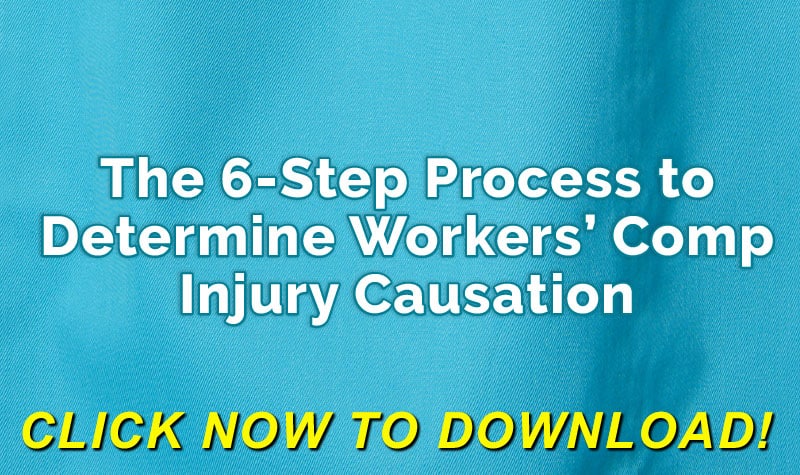
Stakeholders that want to continue seeing positive trends need to keep their eyes on the ball with trends affecting the industry. Many are wondering what’s next? What will be the next development that could unexpectedly drive up pharmaceutical costs among injured workers?
“There’s significant concern over the rising cost of prescription drugs,” according to the Drug Trend Report released by myMatrixx earlier this year. And “there is a lack of understanding about the impact specialty medications may have on workers’ compensation insurance.”
Stakeholders who are aware of, and take steps to address these two issues will be ahead of the game in holding down pharmaceutical costs.
Click Link to Access Free PDF Download
“The 6-Step Process To Determine Workers’ Comp Injury Causation”
Brands vs. Generics
Substituting generics for brand-name drugs where possible is one of the most effective and easiest ways to reduce drug costs in the workers’ compensation system. And yet, there are still many providers who prescribe brand name drugs unnecessarily. These prescribers and their injured-worker patients may be unaware of the cost differences involved.
“Over the past five years, the most commonly used brand-name traditional drugs among injured workers experienced list price inflation of 65.5%, but prices for the most commonly used generic medications declined 35.0%,” according to the myMatrixx report. “In contrast, a market basket of commonly used goods (e.g., milk, bread, etc.) rose only 7.4%.”
As Phil Walls, chief Clinical Office of myMatrixx explained, a generic version of a drug may cost 20 percent of the price of the brand name drug, on average. Spending $100 for a drug that could be purchased for $20 can have a significant impact on costs. But cost is not the only issue.
Many providers and injured workers believe brand name drugs are inherently of better quality than the generic versions. However, they have the same active ingredients and work the same way as brand name drugs.
“A generic medicine is the same as a brand-name medicine in dosage, safety, effectiveness, strength, stability, and quality, as well as in the way it is taken and should be used,” per the Food and Drug Administration.
To gain FDA approval, a generic medication must be ‘bioequivalent’ to the brand name version. That means they are chemically nearly the same, although generic drug makers are allowed 20 percent variation in the active ingredient from the original formula. But according to Harvard researchers, “while the FDA does allow for up to 20 percent wiggle room, in reality, the observed variation is much smaller, 4 percent.”
Several brand name drugs that are widely used among injured workers have patents that have recently expired, such as Lyrica. That’s good news, in that less expensive generic versions will likely come on the market soon. However, stakeholders are advised to ask their pharmacists if the generic may be substituted for the form of a drug that their injured worker is receiving.
For example, some drug makers issue a long-acting version of a medication that is set to expire and set the cost at a lower amount than it would be for 2x the original drug. Providers and patients would be inclined to seek the long-acting version since it would essentially cost less than taking two pills of the original version. However, once the patent expires, patients who are taking the long-acting version won’t be eligible to receive the generic version, which would only be a substitute for the original version.
Some additional drugs with patents expiring this year are Amrix®, Fentora®, Flector®, and Vivlodex®.
Specialty Meds
The vast majority of workers’ compensation payers will likely never encounter a claim that involves specialty drugs. But for those that do, it can be a shock. These drugs comprise just 1.7 percent of claims, yet they drive 7.1 percent of spend. That number represents an increase of 18.5 percent over the prior year.
“On average, payers spent $5,130.57 per injured worker on a specialty medication,” according to the myMatrixx report. “Specialty medications cost four times as much, or more, as traditional medications for payers.”
While those numbers might cause payers to shy away from footing the bill for these medications, that strategy will drive up costs even more. “The maxim that the most expensive specialty drug is the one not taken means that poor adherence on the part of the patient may render even the best therapy ineffective,” the report said. “Compliance is vital; if the patient is not compliant, the course of therapy has to be repeated,” Walls added.
Paying for, and ensuring that injured workers take specialty medications when warranted is, therefore, imperative to achieving the best outcomes and containing costs.
Specialty medications are used for conditions that have not traditionally been associated with injured workers. However, that is changing.
The proliferation of new cancer-presumption laws for firefighters means more cancer drugs will be seen in workers’ compensation claims. Needlestick injuries to healthcare workers and first responders may warrant specialty drugs for HIV and Hepatitis. Specialty drugs for hepatitis C can cost $100,000 for a 90-day supply.
Workers most likely to receive a specialty drug include:
- Emergency first responders
- Public safety personnel
- Law enforcement officers
- Correctional officers
- Healthcare workers
- Certain defined workers in states with cancer presumption laws
Conclusion
Drug spend in the workers’ compensation system can be astronomical, but the costs can be controlled. Staying on top of issues such as generic vs. brand name drugs, and the increased use of specialty medications will help. Working closely with providers, pharmacists, and PBMs is the best way to ensure injured workers get the medications they need without payers spending unnecessarily.

Author Michael Stack, CEO Amaxx LLC. He is an expert in workers’ compensation cost containment systems and helps employers reduce their workers’ comp costs by 20% to 50%. He works as a consultant to large and mid-market clients, is a co-author of Your Ultimate Guide To Mastering Workers Comp Costs, a comprehensive step-by-step manual of cost containment strategies based on hands-on field experience, and is founder & lead trainer of Amaxx Workers’ Comp Training Center.
Contact: mstack@reduceyourworkerscomp.com.
Workers’ Comp Roundup Blog: https://blog.reduceyourworkerscomp.com/
©2019 Amaxx LLC. All rights reserved under International Copyright Law.
Do not use this information without independent verification. All state laws vary. You should consult with your insurance broker, attorney, or qualified professional.






